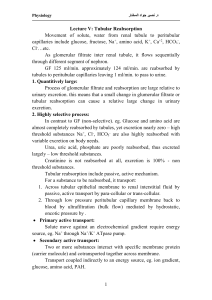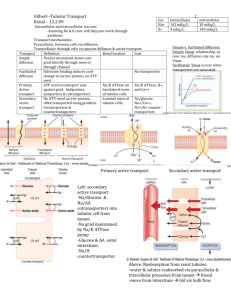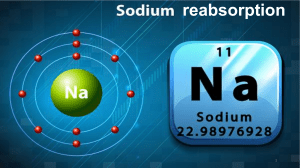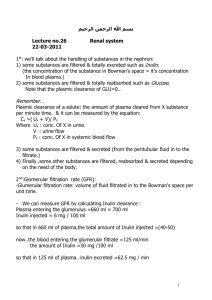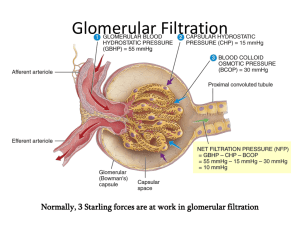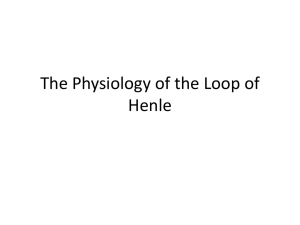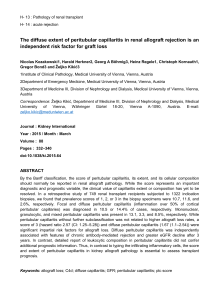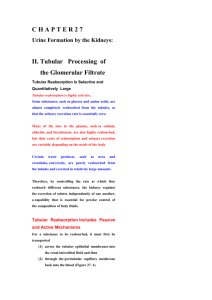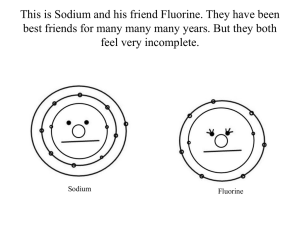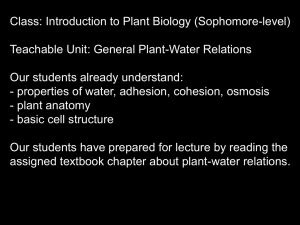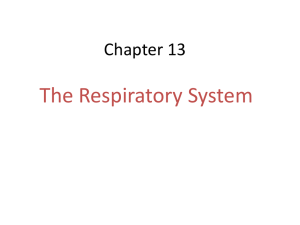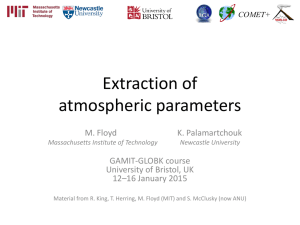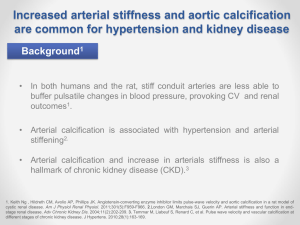Regulation Of Reabsorption
advertisement
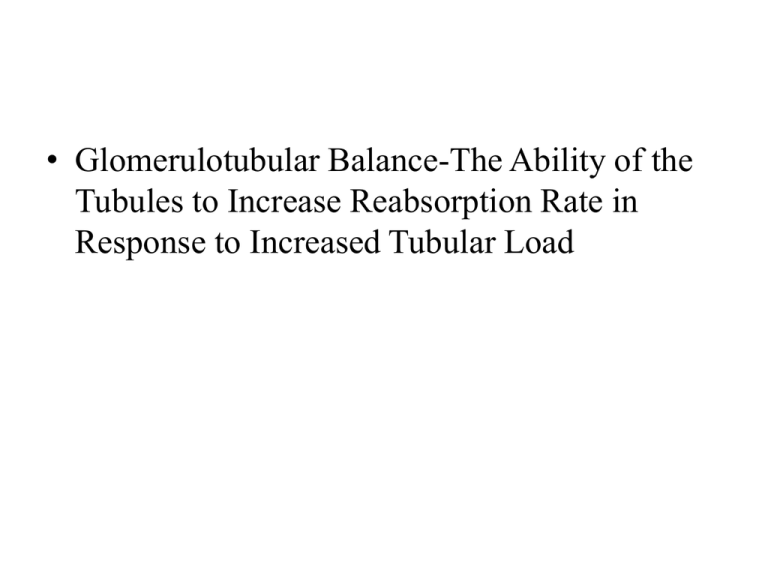
• Glomerulotubular Balance-The Ability of the Tubules to Increase Reabsorption Rate in Response to Increased Tubular Load • Glomerulotubular balance helps to prevent overloading of the distal tubular segments when GFR increases • Glomerulotubular balance acts as a second line of defense to buffer the effects of spontaneous changes in GFR on urine output • The first line of defense includes the renal autoregulatory mechanisms especially tubuloglomerular feedback which helps to prevent changes in GFR • The autoregulatory and glomerulotubular balance mechanisms prevent large changes in fluid flow in the distal tubules Peritubular Capillary and Renal Interstitial Fluid Physical Forces • The normal rate of peritubular capillary reabsorption is about 124 ml/min • The two determinants of peritubular capillary reabsorption that are directly influenced by renal hemodynamic changes are the hydrostatic and colloid osmotic pressures of the peritubular capillaries • The peritubular capillary hydrostatic pressure is influenced by the arterial pressure and resistances of the afferent and efferent arterioles. (1) Increases in arterial pressure tend to raise peritubular capillary hydrostatic pressure and decrease reabsorption rate (2) Increase in resistance of either the afferent or the efferent arterioles reduces peritubular capillary hydrostatic pressure and tends to increase reabsorption rate The constriction of the efferent arterioles increases glomerular capillary hydrostatic pressure but it lowers peritubular capillary hydrostatic pressure • The colloid osmotic pressure of peritubular capillaries is determined by (1) the systemic plasma colloid osmotic pressure; increasing the plasma protein concentration of systemic blood tends to raise peritubular capillary colloid osmotic pressure, increasing reabsorption (2) the filtration fraction; the higher the filtration fraction, the greater the fraction of plasma filtered through the glomerulus and the more concentrated the protein becomes in the plasma that remains behind Thus increasing the filtration fraction also tends to increase the peritubular capillary reabsorption rate • Increases in Kf increases reabsorption, whereas decreases in Kf lowers peritubular capillary reabsorption Effect of Arterial Pressure on Urine Output • Small increase in arterial pressure can cause marked increases in urinary excretion of sodium and water, phenomena referred to as pressure natriuresis and pressure diuresis • Because of the autoregulatory mechanisms increasing the arterial pressure between the limits of 75 and 160 mm Hg has only a small effect on renal blood flow and GFR • A second effect of increased renal arterial pressure that raises urine output is that it decreases the percentage of the filtered load of sodium and water that is reabsorbed by the tubules • The underlying cause for this is that a slight increase in peritubular capillary hydrostatic pressure causes subsequent increase in the renal interstitial fluid hydrostatic pressure • an increase in the renal interstitial fluid hydrostatic pressure enhances backleak of sodium into the tubular lumen, thereby reducing the net reabsorption of sodium and water and further increasing the rate of urine output when renal arterial pressure rises • A third factor that contributes to the pressure natriuresis and pressure diuresis mechanisms is reduced angiotensin II formation Hormonal Control of Tubular Reabsorption • Aldosterone increases sodium reabsorption and stimulates potassium secretion • Major site of aldosterone action is on the principal cells of the cortical collecting tubule • Angiotensin II increases sodium and water reabsorption 1. Angiotensin II stimulates aldosterone secretion 2. Angiotensin II constricts the efferent arterioles which has two effects on peritubular capillary dynamics • It increases sodium and water reabsorption First, efferent arteriolar constriction reduces peritubular capillary hydrostatic pressure which increases net tubular reabsorption especially from the proximal tubules Second, efferent arteriolar constriction by reducing renal blood flow raises filtration fraction in the glomerulus and increases the concentration of proteins and the colloid osmotic pressure in the peritubular capillaries; this increases the reabsorptive force at the peritubular capillaries and raises tubular reabsorption of sodium and water . Angiotensin II directly stimulates sodium reabsorption in the proximal tubules, the loops of Henle, the distal tubules, and the collecting tubules • One of the direct effects of angiotensin II is to stimulate the sodium-potassium ATPase pump on the tubular epithelial cell basolateral membrane • A second effect is to stimulate sodium-hydrogen exchange in the luminal membrane, especially in the proximal tubule • A third effect of angiotensin II is to stimulate sodiumbicarbonate co-transport in the basolateral membrane • ADH increases water reabsorption • Atrial Natriuretic peptide decreases sodium and water reabsorption • Parathyroid hormone increases Calcium reabsorption • Sympathetic nervous system activation increases Sodium reabsorption

